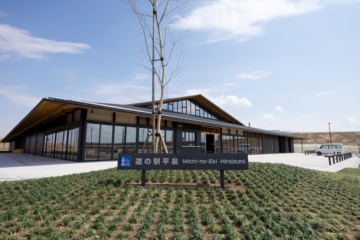MODEL COURSE
Morioka Station
Chusonji Temple [World Heritage Site]
![Chusonji Temple [World Heritage Site]](https://iwatetabi.jp/wp/wp-content/uploads/2024/03/591-328x240.jpg)
Tendai sect, Tohoku Daihonzan. The name of the mountain is Kanzan, and Jikaku Daishi is the founder of the mountain.
At the beginning of the 12th century, the first Lord Kiyohira of the Oshu Fujiwara clan built many temples and pagodas, including the Tahoto and Nikai Daido.
Its purpose was to comfort the spirits of those who died in the long wars of the First Nine Years War and the Second Third Year War, and to build a Buddhist nation.
Unfortunately, the hall and pagoda were destroyed by fire in the 14th century, but it is still a treasure trove of Heian art, containing over 3,000 national treasures and important cultural properties, including the Kaneiroki Hall.
Muryokoin Ruins [World Heritage Site]
![Muryokoin Ruins [World Heritage Site]](https://iwatetabi.jp/wp/wp-content/uploads/2024/03/1679-309x240.jpg)
Muryoko-in Temple, built by the third generation Hidehira, is modeled after the Phoenix Hall at Uji Byodo-in Temple. Hidehira Temple was adjacent to the Garan Imperial Palace, where he lived. Most of the ruins have been turned into rice paddies, but the ruins of the pond, Nakajima, and temple foundation still remain. According to the results of the excavation survey conducted in 1955, it was a magnificent temple, with the axis of the temple running from east to west passing through the east gate, bridge, middle island, and bridge hall, and beyond which one could see Mt. Kinkeizan. It is known that
Detailed Destination InformationKinkeishan [World Heritage Site]
![Kinkeishan [World Heritage Site]](https://iwatetabi.jp/wp/wp-content/uploads/2024/03/1735-320x240.jpg)
Kinkeisan is an elegant conical mountain. There are also legends that say, ``Hidehira lined up his laborers to the Kitakami River, carried stones, and built the mountain in one night,'' and ``Hidehira buried a pair of golden chickens, a male and a female.''
Several sutra mounds were built on the summit of Mt. Kinkeisan. However, it was stolen in 1930 and is currently in a partially destroyed state. The artifacts excavated from that time are kept by the Tokyo National Museum and Motsuji Temple.
Motsuji Temple [World Heritage Site]
![Motsuji Temple [World Heritage Site]](https://iwatetabi.jp/wp/wp-content/uploads/2024/03/2575-331x240.jpg)
Motsuji Temple, the special head temple of the Tendai sect, is called Iozan and was opened in 850 by Jikaku Daishi.
In the late Heian period, the Oshu Fujiwara clan's second and third generation, Motohira and Hidehira, built magnificent temples such as Kondo Enryuji and Kashoji, which numbered 40 halls and pagodas and 500 monks' quarters, making them the largest temple in Japan. It was called the second sacred place.
Unfortunately, the temple at that time was burnt down due to repeated disasters, but today the " Jodo Garden " centered around Oizumigaike Pond and the remains of the temple from the Heian period have been preserved in almost perfect condition, and the country has designated it as a special historic site. It has been designated as a scenic spot.
Kanjizaio-in Temple Ruins [World Heritage Site]
![Kanjizaio-in Temple Ruins [World Heritage Site]](https://iwatetabi.jp/wp/wp-content/uploads/2024/03/668-329x240.jpg)
It is said that the Kanjizaioin Temple ruins adjacent to the east of Motsuji Temple were run by the second wife of Motohira. The temple area is 120m from east to west and 240m from north to south. The square garden pond (Maizuru-ga-ike) with rounded corners is dotted with rock formations made of piled up megaliths similar to rough seashores, a small Suhama beach, and a long central island running east to west. On the north bank is a plaza, towards which are the remains of the Great Amida-do Hall to the west and the remains of the Small Amida-do Hall to the east. On the east bank, there are also the ruins of the bell tower and the ruins said to be Fugendo.
Detailed Destination InformationRoadside station “Hiraizumi”

Roadside Station Hiraizumi opened on April 27, 2017.
In addition to fresh produce produced by local farmers, the farm-fresh corner sells delicious items such as doburoku and wine that are designated as special zones.
Ichinoseki Station

![[Taxi Plan] World Heritage Hiraizumi Course](https://iwatetabi.jp/wp/wp-content/uploads/2024/03/1735.jpg)
![[Snow and hot springs! Touring the foothills of Mt. Iwate in winter] 7-hour course](https://iwatetabi.jp/wp/wp-content/uploads/2024/03/1773-2-360x240.jpg)
![[Taxi plan] Koiwai Farm 3-hour course](https://iwatetabi.jp/wp/wp-content/uploads/2024/03/46aeea07d394e8fd0a58a303888c6b2c-320x240.jpg)
![[Morioka Hometown Guide] E course](https://iwatetabi.jp/wp/wp-content/uploads/2024/03/2030-320x240.jpg)